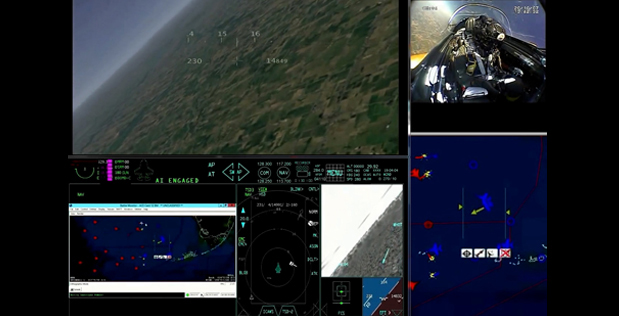Press Release
Johns Hopkins APL Bridges the Gap with Next Phase of DARPA’s ACE Program
After the success of last summer’s AlphaDogfight Trials (ADT), which saw artificial intelligence (AI) beat an experienced human F-16 fighter pilot in a simulated aerial battle, the Defense Advanced Research Projects Agency's (DARPA) Air Combat Evolution (ACE) program has hit new milestones in the quest to forge greater trust in autonomous systems for air combat.
A team at the Johns Hopkins Applied Physics Laboratory (APL) in Laurel, Maryland, previously created the simulation environment and adversary agents for all three ADT competitions — and continues to leverage its capabilities in AI and software development, modeling and simulation, and aircraft dynamics and controls to support the next phase of the ACE program.
As ACE nears the halfway mark of the program’s first phase, APL continues to enhance the virtual environment and AI algorithms to create more evolved dogfighting scenarios. This past February, the Laboratory hosted the first follow-up scrimmage utilizing its more challenging AI algorithms and simulated sequences. Last year’s competitions focused on 1-v-1 scenarios; this time, teams engaged in 2-v-1 fights, with two friendly “blue” F-16s working as a team against a single enemy “red” aircraft. They also had additional elements, such as a gun for precise, shorter-range shots and a missile for longer-range targets, thrown into the mix. The simulated fights pave the way for Phase 2’s live subscale aircraft dogfights later this year.
ACE is one of several programs designed to enable DARPA’s “mosaic warfare” vision, a combination of manned and less-expensive unmanned systems that can be continuously modified with the latest technology.
“ACE builds upon ADT and expands the mission,” said Stephen Vance, APL principal investigator for ACE. “APL is supporting this next phase by providing the modeling and simulation (M&S) environment that extends AlphaDogfight from 1-v-1 to up to 2-v-2 engagements and adds missiles and safety considerations. We are creating the M&S for large-scale exercise scenarios for AlphaMosaic, and we are pressing ahead with developing smart red agents for AlphaDogfight and AlphaMosaic.”
APL also served as technical advisor on trust assessment, another key focus area for the ACE program. To measure pilot trust in AI, the ACE program strove to capture data by having test pilots fly in the back seat of an L-29 jet trainer outfitted with sensors to measure their physiological responses while another pilot acting as the AI conducted combat maneuvers in the cockpit.
All of this work builds toward the program’s Phase 3, which will see the first L-39 full-scale jet trainer piloted by AI go up against actual adversaries in late 2023 and 2024. As science and technology company Calspan creates a performance model of the craft, APL is performing risk reduction for that effort by taking algorithms from the simulated environment and putting them onto APL subscale aircraft to help inform the transition to live aircraft.
“As the experiment integration team, we are essentially integrating all of these aspects into one cohesive and synchronized program, providing technical direction and coordination between DARPA and the nine performers,” said APL program manager Chris DeMay. “APL is playing an important role bridging the gap; we’re transitioning these AI capabilities from the computer to real world, and, eventually, full-scale aircraft.”
Learn more about DARPA’s ACE program here.
